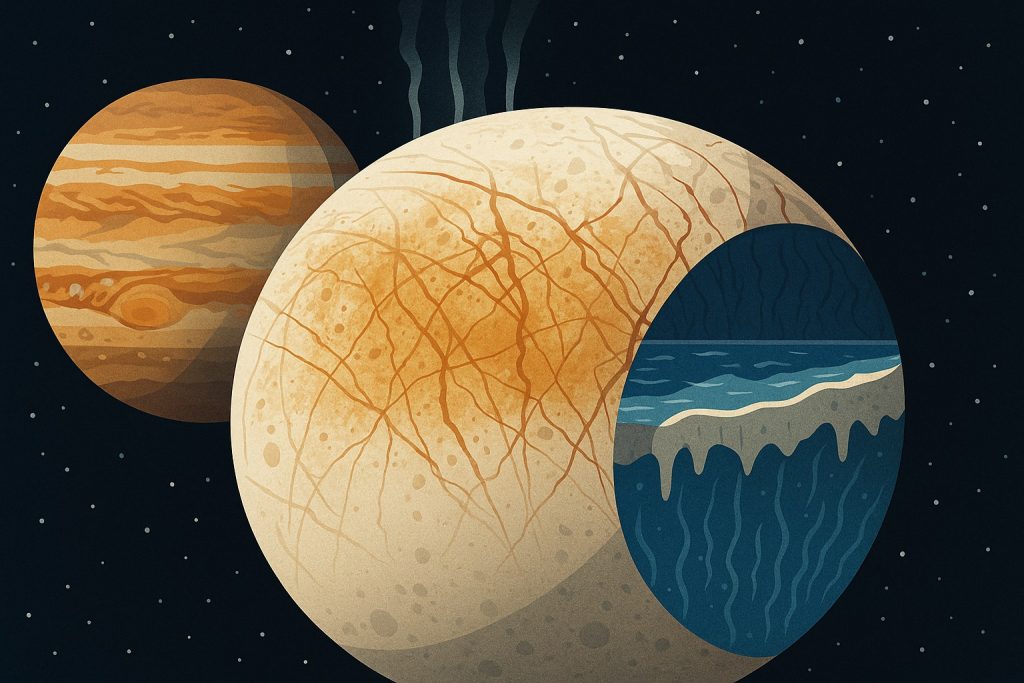Among the dozens of moons orbiting Jupiter, Europa stands out as one of the most intriguing. Though only slightly smaller than Earth’s Moon, Europa holds great scientific interest because of what lies beneath its frozen surface — a vast subsurface ocean that may harbor the conditions for life. This article explores Europa’s structure, surface, and the potential for habitability that has captivated scientists around the world.
Basic Facts About Europa
- Diameter: 3,121 km (slightly smaller than Earth’s Moon)
- Distance from Jupiter: ~670,900 km
- Orbital period: ~3.5 Earth days
- Surface temperature: Averages around –160°C
- Discovery: 1610 by Galileo Galilei
- One of the four Galilean moons, alongside Io, Ganymede, and Callisto
A World of Ice and Water
Europa is covered in a thick shell of solid water ice, but beneath that icy crust lies something remarkable: strong evidence points to a global ocean of liquid water.
Evidence for a Subsurface Ocean
- Europa’s smooth, cracked surface suggests floating ice plates, similar to Earth’s sea ice
- Magnetic field readings from NASA’s Galileo spacecraft indicate a conductive layer, likely salty water
- Observations of water plumes erupting from the surface, similar to geysers
- Tidal heating from Jupiter’s gravity keeps the internal ocean from freezing completely
Europa’s Surface Features
Europa has one of the youngest and smoothest surfaces in the Solar System, with relatively few impact craters. Key features include:
- Lineae: long, dark streaks caused by fractures in the icy crust
- Chaos terrain: regions of broken, jumbled ice blocks, possibly formed by melting and refreezing
- Reddish discoloration: may come from salts or sulfur compounds from the subsurface ocean
These surface features may offer windows into the ocean below, making them prime targets for exploration.
Could Life Exist on Europa?
Europa is considered one of the most promising places in the Solar System to search for extraterrestrial life, thanks to:
- Liquid water, a key ingredient for life
- Chemical nutrients possibly delivered from surface ice, ocean floor reactions, or comets
- Energy from tidal forces and possibly hydrothermal vents on the ocean floor
If life does exist there, it might resemble deep-sea organisms found near Earth’s hydrothermal vents — microbes or simple multicellular life adapted to total darkness and high pressure.
Missions to Explore Europa
Past Missions
- Galileo (1995–2003) provided most of what we know about Europa
- Hubble Space Telescope has observed possible water vapor plumes
Upcoming and Future Missions
- Europa Clipper (NASA, launching 2024): will conduct dozens of flybys to analyze the surface, ice thickness, and subsurface ocean
- JUICE (ESA’s Jupiter Icy Moons Explorer, launched 2023): will study Ganymede but also conduct multiple flybys of Europa
In the long term, scientists hope to land probes or even send submersibles beneath the ice to explore the ocean directly.
Conclusion
Europa is more than just a frozen moon — it’s a potential ocean world, teeming with scientific mysteries and perhaps even life. With new missions on the horizon, this icy satellite of Jupiter could become one of the most important discoveries in planetary science and astrobiology in the coming decades.
Glossary
- Subsurface ocean – an ocean that exists beneath the surface of a planet or moon
- Tidal heating – warming of a moon’s interior caused by gravitational forces
- Lineae – linear features or cracks on Europa’s icy surface
- Chaos terrain – disrupted areas of broken ice, thought to result from melting and movement
- Hydrothermal vents – cracks on the seafloor that release heat and chemicals, supporting unique ecosystems


